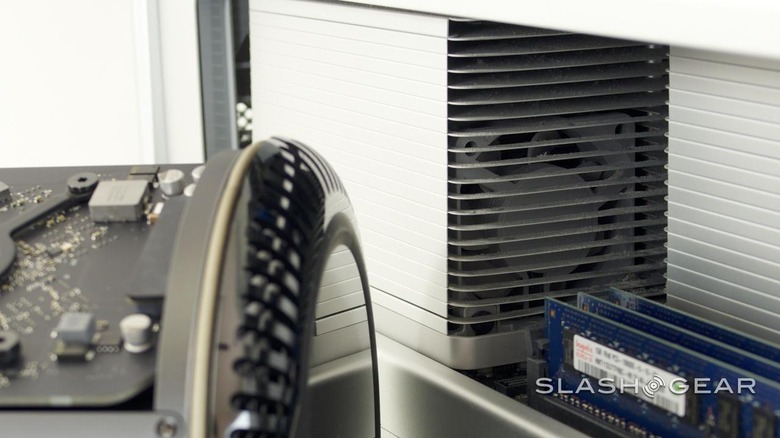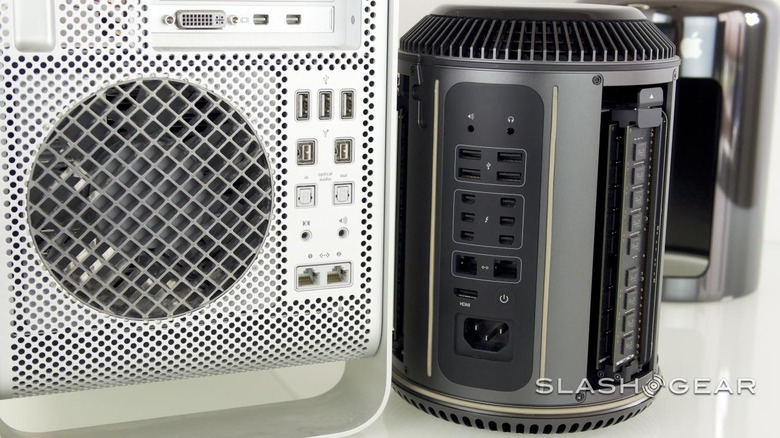Apple May Be Overthinking The New Mac Pro
The new Mac Pro should be easy for Apple, and the fact that it isn't is making people worried. A modern workstation has a lot in common with a workstation a decade old, or two: the fastest components available in a form-factor that doesn't tie you down. If there's one thing we know about Apple, however, it's that if there's an easy way to do something, or an alternative way that could be considered more elegant, it has an uncontrollable desire to chase the latter. The recipe envisaged by some of the more vocal would-be Mac Pro buyers seems a lot more straightforward.
Take a box. A big box. Put a Xeon processor in there. Maybe two. Leave plenty of space left over for PCIe cards, even after you jam a load of fast RAM and solid-state storage inside. Slap an Apple logo on the front.
If that sounds familiar, it's probably because it sounds a whole lot like the Mac Pro that Apple retired in favor of its all-new cylindrical redesign in 2013. The aluminum desktop chassis looks boxy in comparison to the sleek all-in-ones and notebooks that dominate the company's range today, but it was undoubtedly a case of form following function.
I'm invariably impressed by Apple's relentlessness when it comes to enacting its own visions. I don't necessarily agree with, or like, the final products that come from that process, but I suspect it's one that most device-owners in the tech space owe some debt to. I'm not sure Android enthusiasts would have such compelling smartphones, or Windows users would have potent laptops like the Surface Book, were it not for Apple's unstinting pressure on the market.

That said, there are clear signs that such a resolute fix on carrying a plan through to fruition can blind you to legitimate questions. Not to mention going further in that process than, arguably, anybody actually wanted from you. Perhaps Apple is right that it's not ergonomically ideal to reach across your laptop's keyboard and tap a touchscreen, but maybe that's still a better solution than the Touch Bar. Maybe Thunderbolt 3 and USB-C are the future of connectivity, but perhaps it was too eager to make a wholesale switch to them.
Apple admits, now, that the headline decisions it made around the 2013 Mac Pro were actually at the core of its downfall. The company predicted that the future of workstations would be harnessing multiple GPUs and adding external expansion through Thunderbolt 2, and designed the whole computer around that. It wasn't necessarily a bad prediction – though hindsight tells us neither of those bets were how the market actually went – but the aggressive way in which Apple honed the cylindrical computer meant it simply didn't have the capacity to embrace any alternative.
My concern – and, I suspect, that of many with a vested interest in how the new Mac Pro of 2019 turns out – is that Apple's desire to take an idea to its purest conclusion may again squeeze out what makes a workstation appealing to professionals in the process. A lot of what the new Pro Workflow Team is doing, smoothing away the everyday bumps, hiccups, and annoyances that power-users face, sounds great. Some of Apple's internal experimentation with what it's describing as "modularity," however, may be a case of two groups using the same word but with very different definitions in mind.
Now, I don't believe for a minute that Apple has tipped its whole hand here. The company is just too cunning for that. But the vision of modularity that TechCrunch outlines from its visit to Apple's labs does sound a whole lot like its vision for consumer devices, expanded to encompass pro-users too.
"It's not just MacBook Pro, iMac Pro, Mac Pro — it's the enabling force of eGPUs, it's iPad Pros as input devices, purpose-built extensions and portable workstations," author Matthew Panzarino writes. "And it's even iPhone, as Logic and Final Cut Pro are both completely compatible with GarageBand and iMovie. You can start a project and continue it on iOS while traveling, then put it right back into your pro machine when you're back and continue riffing."

External GPUs are certainly going to be an increasing part of the computing landscape. USB-C and Thunderbolt 3 are, too. Certainly, high-powered tablets like the iPad Pro have demonstrated that non-traditional interfaces – beyond keyboard and mouse – could have an increasing role to play, not just as a makeshift alternative but in introducing truly new efficiencies.
All the same, I don't necessarily believe professionals have those same cross-device expectations, from machines that are essentially for work, as consumers do – or, at least, as Apple believes consumers do. Sometimes it does feel like company has a rose-tinted vision of its users and how they'll interact with their gadgets. The mass market, I suspect, is more willing to reshape its expectations to suit that vision than are professionals needing a big, powerful box that runs macOS.
Certainly, the pros will humor such alternative visions, but only if they don't have to sacrifice their core needs to do so. In short, Apple's more advanced ecosystem of modularity is fine, just as long as the more mundane type of modularity is there too. That still means being able to add graphics cards, and extra storage, and other new components, without being tied into an expensive or otherwise limited form-factor or connectivity type. Apple made that mistake in 2013, and has been hearing about it for five years now. Here's hoping the message sunk in.
